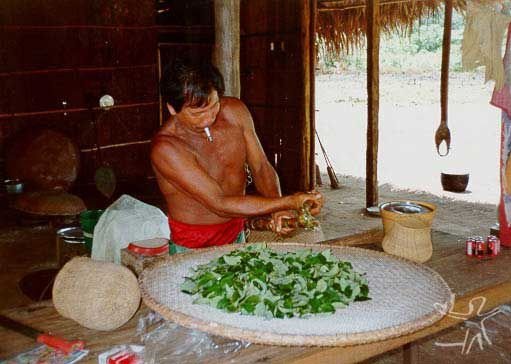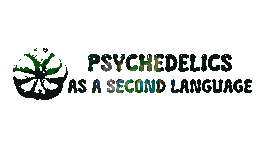Euphoric ashes and Clinical Cocaine
In the depths of the Amazon rainforest, tribes remain without any civilized contact, they hunt as our primordials did centuries ago, for that same purpose they need to be always alert and have inhuman stamina, strength or sickness they seek for plants to provide those elements and only shamans (some languages translated to clever man) have that knowledge in between them, Mambe.
Mambe or Ypadú is a crude powder made out of Coca leaves (Erythroxylum Coca) and ashes of several other plants, traditionally the Coca leaves would be toasted in am earthenware pot, crushed and mixed with the ashes from Yarumo (Cecropia spp.)


Credit to:Jorge Pozzobon, 1997
The Ypadú powder is stored in a hollowed-out calabash, and scooped out with a spatula made from the legbone of a peccary or tapir. About a teaspoon of the powder is placed between the cheek and gum and molded into a quid, which is not chewed but allowed to gradually dissolve and be swallowed, in recent experiments done by Anthony Henman in Lima and São Paulo have shown a modern way of creating Mambe and proved that any variety of coca leaf can be used and mixed with the ashes of quinoa straw.
Natives would use this method to increase their focus, give them a boost of strength, energy, and pain reliever, it helps in digestion and suppressing fatigue, hunger, thirst needed for long hunts, long expeditions looking for food or needed items for survival, as the name indicated the most known alkaloid present in Erythroxylum Coca is Cocaine (0.3 to 1.5%, averaging 0.8%) in fresh leaves.
Both Coca and Cocaine have a place in clinical and pharmaceutical history, as early as the 19th century some recipes have been scavenged, recipes such as:
Elixir Cocæ
1 in 6 of simple elixir, the dose would consist of 1 to 4 drachms in water.
Extractum Cocæ Liquidum
Distilling the spirit and concentrating the mixture by evaporation, a solid semialcoholic preparation is obtained, this mixture is stronger than the recipe above. It is known as Extractum Cocæ, the dosage would vary from 2 to 15 grains in pills or tablets.
Infusum Cocæ
1 in 50 boiling water, as the name describes an infusion made from coca leaves, this brew would be prepared like a hot tea with milk and sugar or with a slice of lemon, it would also be used in tonsillitis administered by gargling with warm water.
Pastillus Cocæ
Coca Pastils, 2 and a half grains of the extract, one every two to 3 hours. They would be administered to patients with asthma, hay fever, spasmodixaathma, and postnasal catarrh.
Vinum Cocæ
1 in every 8 of sherry, this wine brew sometimes administered with water wasn’t sold without a license.
Coca Wine
This was the most popular form, 1 in 20 or 30 of a red wine, the dosages were measured by “wineglassful” this practice was used for irritable stomach and vomiting.
Often Cocaine (Cocaina) and its salts would be used.
Doses would vary from 1/20 to 1 grain in a pill or tablet, the alkaloid was first isolated by Niemann in 1860, the formula C32H20NO8 was given, later to be assigned as C17H21NO4 by Lossen in 1862. Cocaine crystalizes in monoclinic prisms and it requires around 700 ml to dissolve in water, it dissolves quicker in hot water, but rapidly decomposes forming an acid solution containing benzoyl-ecgonine, ecgonine, and benzoate of cocaine, these compounds don’t separate after cooling down. Cocaine is also soluble in alcohol about 1 in 20, in chloroform, ether about 1 in 3, and plenty other volatile oils and fixed oils.
According to Hesse (A story of Coca Leaves and their Alkaloids 1891), the alkaloids Hygrine, Benzoyl-Ecognine and Ecognine, Cocamine and Cocaidine, as well as CocaTannin and Coca Wax were met, Hesse claimed that all the Coca alkaloids derived from Ecognine methyl ester and ecognine itself from pyridine, being cocaine the most notable among the others.
As pure Cocaine is soluble in fats and oils its salts are not, that meaning it should always be used when combined with fatty or oily substances.
Bougies of Cocaine
1/2 grain with cacao-butter was often used for painful affections of the urethra.
Cerarum Cocainæ
1in 30 of petroleum cerate. Used for burns, urticaria, and pruritus.
Collodium Cocainæ
2% in collodion. Diminishes itching and cures inflamed chilblains
Emplastrum Cocainæ
1dissolved in 50 of lead plaster heating in a water bath. For intercostal neuralgia, sciatica, bruises.
Oleatum Cocainæ
A saturated solution of the alkaloid in oleic acid, which hasn’t been proved to be satisfactory. Oleum cum Cocaina. 2% solution in almond oil or any other nut oil. Used for earache, for the eye, a 2% solution in castor oil was advised for catheters.
Suppositories and Pessaries of Cocaine
1/2 grain or more if advised by a physician with cacao-butter.
Tabellæ Cocainæ
1/twentieth grain in each with chocolate, it would be administered every quarter, half-hour or hour, quickly eaten and swallowed for seasickness, chloroform or alcohol sickness, pregnancy sickness, etc.
Unguentum Cocainæ
1 in 30 of lard or lanoline, cocaine is soluble in anhydrous lanoline if warmed. It would be absorbed for facial neuralgia, shingles, eczema, urticaria, etc.
Vaselinum Cocainæ
4% suitable for smearing catheters, burns, scalds. Citrate of cocaine is used by dentists, the adequate dosage would be from 1/20 to 1 grain. Cocainæ Hydrobromas Dosage 1/20th to 1 grain in a pill or solution, a stable salt, in odorless, small, and acicular crystals.
Cocainæ Hydrochloras
The medical Rolls Royce of Cocaine salts, 1/5 to 1 grain was given in aqueous solution pill or pastil, this method was the most used among clinics as a local anesthetic, if pure it’s hard, colorless, granularlooking crystals, if inspected by light it has a distinct chemiluminescense, it is odorless and pretty much tasteless. It is soluble in spirit and glycerine, insoluble in ether, fats, and oils, therefore, it isn’t compatible with them.

This salt will crystallize with two molecules of water but the anhydrous salt alone is official. When it dissolves in cold sulphuric acid there is some effervescence but colorless, but chars if heated. If ignited it burns without residue. If one drop of a solution of permanganate of potassium is added to a solution of 1grain in a drachm of distilled water, acidulated with three drops of sulphuric acid (diluted) the bright deep color should remain unchangeable indicating the absence of other Coca alkaloids.
The salt should not only be in a good crystalized form but should yield a distinctly crystalline precipitate of pure cocaine within three minutes when 1 grain is dissolved in two ounces of water and added six to eight drops of Ammonia, are added and well stirred. The precipitate redissolves in 24hours or more, the cocaine is then converted into methyl alcohol and benzoyl-ecgonine.
If there is a trace quantity of calomel and breathed upon the mixture turns black, this will only happen with the salts of cocaine, not the alkaloid itself.
As an aqueous solution of sulfate of atropine and so with the aqueous solution o hydrochlorate of cocaine some samples seem prone to grow in fungi while others don’t. This fungoid grows have related troublesome uses in the application of cocaine as a local anesthetic in several dental and eye operations. Whether those happenings were caused by the impurity of the salts or the condition or idiosyncrasy of the patients remains unknown.
Various modes to keep the solution fungus free have been suggested throughout the time, carbolic, boric and benzoic acids, perchloride of mercury thymol, camphor, and chloroform have been added to check their growth. Boric acid has been the most recommended of Boric acid grows fungi itself sometimes. Chloroform is unobjectionable except for eye drops, perchloride of mercury is useless as it forms a double salt with Cocaine. Salicylic acid has been proven to be the most effective.
Buginaria Cocainæ Hydrochloratis
Onesixth of a grain in each gelato- glycerine basis, used in hay fever sometimes combined with 1 hundred
twentieth of Sulphate of Atropine in each.
Injection Cocainæ Hydrochloratis Hypodermica
1 in twentieth, used for sciatica and many other local infections it acts better than Morphine. Hypodermic Lamels are prepared containing 1 fourth grain in each Lamellæ Cocainæ. Gelatinous discs containing 1 two-hundredth grain of hydrochlorate of Cocaine, these should be prepared in a sterile environment free from dust, fungi, germs, or diseases. Also combined with Atropine, Homatropine, and Physostigmine
Liquor.
Cocainæ Hydrochloratis
10 percent of Hydrochlorate of Cocaine solution, 2 or 10 minims, Hydrochlorate of cocaine 100 salicylic acid 1 in 1/2, boiling distilled
water to produce fluid parts when cold.
Pastillus Cocainæ Hydrochloratis
1/20 grain to 1/5grain or more if ordered. It was often used for irritation of the throat and hoarseness, invigorate the vocal organs of spokesman and singers.
Pastillus Cocainæ et Morphinæ
Contains 1/30 grain of Cocaine and 1/60 grain morphine. Used for coughs
Pilula Cocainæ Hydrochloratis
1/5 grain in each with sugar of milk and syrup o make a grain pill.
Tabloids of Hydrochlorate of Cocaine
1/10 and 1/6 grain each, the mixture would be prepared for hypodermic injection.
Trochisci Cocainæ Hydrochloratis
1/12 grain the use would be similar to the pastils
Cocainæ Salicyclas
1/5 to 1 frain or more recommended for the use of oculists and in spasmodic asthma.
Dentrifricium Cocainæ
2 ounces Dried Phosphate of Calcium 1 ounce of Powdered Orris 30 grains of Myrrh in powder Mix ad add in a solution of Cocaine
1.1/2 and 12 minims of eucalyptus oil. Used for spongy gums and toothache.
The use of Coca’s alkaloids was prolonged until today, being Cocaine the most well-known alkaloid, matter a fact, Cocaine Hydrochloride is still used clinically and it’s considered as a schedule II drug in the United States and can still be prescribed as a local anesthetic in certain cases of eye, ear, or throat surgeries.
Sources:
William Martindale “Coca and Cocaine, Their History, Medical and Economic Uses, and Medicinal Preparations”
Theodor Koch-Grunberg, “From Roraima to Orinoco” and “Two years among the indians”.
